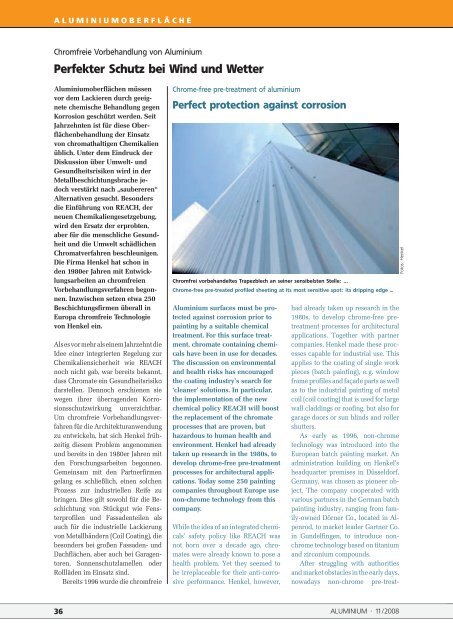SPecIAL - Alu-web.de
SPecIAL - Alu-web.de
SPecIAL - Alu-web.de
You also want an ePaper? Increase the reach of your titles
YUMPU automatically turns print PDFs into web optimized ePapers that Google loves.
A L U M I N I U M O b e r f L ä c h e<br />
Chromfreie Vorbehandlung von <strong>Alu</strong>minium<br />
Perfekter Schutz bei Wind und Wetter<br />
<strong>Alu</strong>miniumoberflächen müssen<br />
vor <strong>de</strong>m Lackieren durch geeignete<br />
chemische Behandlung gegen<br />
Korrosion geschützt wer<strong>de</strong>n. Seit<br />
Jahrzehnten ist für diese Oberflächenbehandlung<br />
<strong>de</strong>r Einsatz<br />
von chromathaltigen Chemikalien<br />
üblich. Unter <strong>de</strong>m Eindruck <strong>de</strong>r<br />
Diskussion über Umwelt- und<br />
Gesundheitsrisiken wird in <strong>de</strong>r<br />
Metallbeschichtungsbrache jedoch<br />
verstärkt nach „saubereren“<br />
Alternativen gesucht. Beson<strong>de</strong>rs<br />
die Einführung von REACH, <strong>de</strong>r<br />
neuen Chemikaliengesetzgebung,<br />
wird <strong>de</strong>n Ersatz <strong>de</strong>r erprobten,<br />
aber für die menschliche Gesundheit<br />
und die Umwelt schädlichen<br />
Chromatverfahren beschleunigen.<br />
Die Firma Henkel hat schon in<br />
<strong>de</strong>n 1980er Jahren mit Entwicklungsarbeiten<br />
an chromfreien<br />
Vorbehandlungsverfahren begonnen.<br />
Inzwischen setzen etwa 250<br />
Beschichtungsfirmen überall in<br />
Europa chromfreie Technologie<br />
von Henkel ein.<br />
Als es vor mehr als einem Jahrzehnt die<br />
I<strong>de</strong>e einer integrierten Regelung zur<br />
Chemikaliensicherheit wie REACH<br />
noch nicht gab, war bereits bekannt,<br />
dass Chromate ein Gesundheitsrisiko<br />
darstellen. Dennoch erschienen sie<br />
wegen ihrer überragen<strong>de</strong>n Korrosionsschutzwirkung<br />
unverzichtbar.<br />
Um chromfreie Vorbehandlungsverfahren<br />
für die Architekturanwendung<br />
zu entwickeln, hat sich Henkel frühzeitig<br />
diesem Problem angenommen<br />
und bereits in <strong>de</strong>n 1980er Jahren mit<br />
<strong>de</strong>n Forschungsarbeiten begonnen.<br />
Gemeinsam mit <strong>de</strong>n Partnerfirmen<br />
gelang es schließlich, einen solchen<br />
Prozess zur industriellen Reife zu<br />
bringen. Dies gilt sowohl für die Beschichtung<br />
von Stückgut wie Fensterprofilen<br />
und Fassa<strong>de</strong>nteilen als<br />
auch für die industrielle Lackierung<br />
von Metallbän<strong>de</strong>rn (Coil Coating), die<br />
beson<strong>de</strong>rs bei großen Fassa<strong>de</strong>n und<br />
Dachflächen, aber auch bei Garagentoren,<br />
Sonnenschutzlamellen o<strong>de</strong>r<br />
Rolllä<strong>de</strong>n im Einsatz sind.<br />
Bereits 1996 wur<strong>de</strong> die chromfreie<br />
Chrome-free pre-treatment of aluminium<br />
Perfect protection against corrosion<br />
Chromfrei vorbehan<strong>de</strong>ltes Trapezblech an seiner sensibelsten Stelle: ...<br />
Chrome-free pre-treated profiled sheeting at its most sensitive spot: its dripping edge …<br />
<strong>Alu</strong>minium surfaces must be protected<br />
against corrosion prior to<br />
painting by a suitable chemical<br />
treatment. For this surface treatment,<br />
chromate containing chemicals<br />
have been in use for <strong>de</strong>ca<strong>de</strong>s.<br />
The discussion on environmental<br />
and health risks has encouraged<br />
the coating industry’s search for<br />
‘cleaner’ solutions. In particular,<br />
the implementation of the new<br />
chemical policy REACH will boost<br />
the replacement of the chromate<br />
processes that are proven, but<br />
hazardous to human health and<br />
environment. Henkel had already<br />
taken up research in the 1980s, to<br />
<strong>de</strong>velop chrome-free pre-treatment<br />
processes for architectural applications.<br />
Today some 250 painting<br />
companies throughout Europe use<br />
non-chrome technology from this<br />
company.<br />
While the i<strong>de</strong>a of an integrated chemicals’<br />
safety policy like REACH was<br />
not born over a <strong>de</strong>ca<strong>de</strong> ago, chromates<br />
were already known to pose a<br />
health problem. Yet they seemed to<br />
be irreplaceable for their anticorrosive<br />
performance. Henkel, however,<br />
had already taken up research in the<br />
1980s, to <strong>de</strong>velop chromefree pretreatment<br />
processes for architectural<br />
applications. Together with partner<br />
companies, Henkel ma<strong>de</strong> these processes<br />
capable for industrial use. This<br />
applies to the coating of single work<br />
pieces (batch painting), e. g. window<br />
frame profiles and faça<strong>de</strong> parts as well<br />
as to the industrial painting of metal<br />
coil (coil coating) that is used for large<br />
wall claddings or roofing, but also for<br />
garage doors or sun blinds and roller<br />
shutters.<br />
As early as 1996, nonchrome<br />
technology was introduced into the<br />
European batch painting market. An<br />
administration building on Henkel’s<br />
headquarter premises in Düsseldorf,<br />
Germany, was chosen as pioneer object.<br />
The company cooperated with<br />
various partners in the German batch<br />
painting industry, ranging from familyowned<br />
Dörner Co., located in Alpenrod,<br />
to market lea<strong>de</strong>r Gartner Co.<br />
in Gun<strong>de</strong>lfingen, to introduce nonchrome<br />
technology based on titanium<br />
and zirconium compounds.<br />
After struggling with authorities<br />
and market obstacles in the early days,<br />
nowadays nonchrome pretreat<br />
Fotos: Henkel<br />
36 ALUMINIUM · 11/2008
















